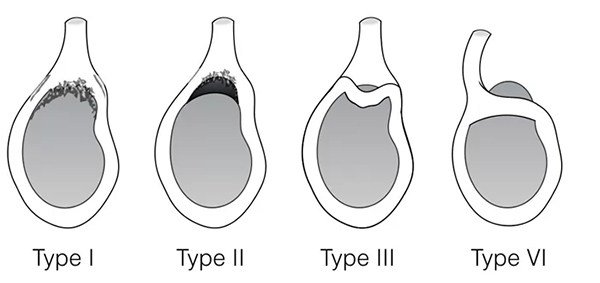SLAP Tears
The shoulder is made up of two joints, the acromioclavicular joint and the glenohumeral joint. The glenohumeral joint is a ball and socket joint. The socket is the flat, shallow surface called the glenoid, and the head of the humerus is the ball. Articular cartilage, which is a shiny white tissue, covers both the ball and the socket and functions to reduce friction for smooth joint movement. The labrum is a thin piece of soft tissue that lines the rim of the glenoid. The labrum creates a deeper socket that molds to fit the humeral head, aiding in the overall stability of the glenohumeral joint of the shoulder. The joint capsule is a fluid-filled sac that surrounds the shoulder joint and provides lubrication for joint movement.
A SLAP tear, or Superior Labrum Anterior and Posterior tear, is a common type of shoulder injury. The labrum is a cup-shaped ring of tissue that lines and supports the ball and socket of the shoulder joint. The humeral head is the ball of the shoulder joint and is much larger than the flat glenoid socket. The surrounding labrum serves as a protection for additional shoulder stability. Many important shoulder ligaments also attach to the labrum. In a SLAP injury, the top part of the labrum is injured, which serves as the biceps tendon attachment. This complex is commonly injured in athletes and can be a common source of pain.

There are three ways to tear your labrum:
- Overuse: Overuse can occur in those who use their shoulder repetitively. Anyone can develop a SLAP tear, however, athletes involved in sports that require repetitive overhead activities are more likely to develop a SLAP tear, such as baseball pitchers, weightlifters, and volleyball players. In addition, individuals whose jobs require repetitive overhead motion are also at an increased risk of developing a SLAP tear.
- Traumatic Injury: Injuries causing a labrum SLAP tear can happen when you fall and stretch out your arm to break the fall. A shoulder dislocation can also lead to a SLAP tear.
- Wear and tear: Degeneration of the labrum occurs slowly over time, resulting in tearing or fraying of the labrum. This is more common in people over the age of 40, when your cartilage becomes more brittle with age.
- Intermittent or constant deep shoulder pain, particularly with overhead activity.
- Weakness
- Swelling
- Popping, catching, locking, or grinding sensation with arm movement.
- Stiffness and decreased shoulder range of motion due to pain.
The combination of a detailed history, comprehensive physical examination, x-rays, and an MRI (magnetic resonance imaging) is the key to a successful diagnosis of a SLAP tear. Dr. Jorge Chahla and his team will conduct a physical exam to check the range of motion, strength, and stability of the shoulder. Dr. Chahla may perform specific tests by placing your arm in different positions to reproduce your symptoms.
An X-ray will be ordered to make sure there are no other problems in the shoulder, such as arthritis or fractures.
An MRI is an important diagnostic imaging test to evaluate the full extent of the injury and the quality of the labrum tissue. The MRI also allows Dr. Chahla to fully assess surrounding shoulder structures, including the biceps tendon and rotator cuff.
A SLAP tear (superior labrum anterior to posterior tear) affects the cartilage ring around the shoulder socket, causing pain, clicking, and shoulder weakness. These injuries commonly occur due to overuse, trauma, or repetitive overhead movements. Dr. Jorge Chahla specializes in SLAP tear diagnosis and treatment, helping patients restore shoulder strength and mobility. If you are experiencing shoulder pain and instability, contact Dr. Chahla’s office in Chicago, Naperville, or Oak Brook for expert evaluation.
At a Glance
Dr. Jorge Chahla
- Triple fellowship-trained sports medicine surgeon
- Performs over 700 surgeries per year
- Associate professor of orthopedic surgery at Rush University
- Learn more

